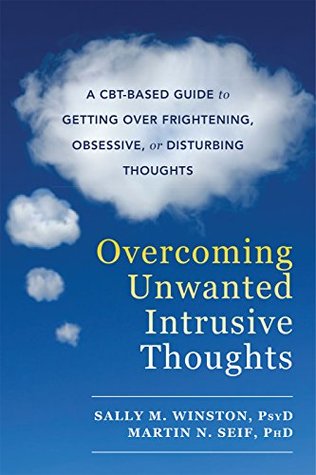More on this book
Community
Kindle Notes & Highlights
Read between
August 23 - August 30, 2020
Or is there a thought that drives you crazy because you just can’t manage to get it out of your mind?
An unwanted intrusive thought starts as just an ordinary intrusive thought, weird, funny, or repugnant as it may be. But not wanting the thought, worrying about it, or fighting with it stops it from passing quickly.
Because you worry about it, reject it, and try to push it out of your mind, it pushes back and becomes a recurring thought or image.
An unwanted intrusive thought sometimes feels like an impulse to perform an unwanted action. Other times, it feels impossibly stuck in your head. Your efforts to deal with it become all-encompassing and take up so much time, mental energy, and focus that your quality of life is degraded.
Let’s start with Worried Voice, the voice of frightening imaginings. Worried Voice is the voice of “What if?” Worried Voice articulates the fears and doubts and misguided conclusions that predict tragedies and awful outcomes. This voice can seem irrational, ridiculous, even perverse, or downright crazy. Sometimes Worried Voice issues strange or urgent warnings. It interrupts, annoys, scares, and talks back. Worried Voice raises anxiety.
Helpful Fact: Thoughts stick because of the energy you expend to fight them.
So the content of unwanted intrusive thoughts is the opposite of what you want to be thinking about. It is the opposite of your values, the opposite of your wishes, and the opposite of your character. It is the opposite of you.
You might have already discovered some of the factors. People are much more prone to unwanted intrusive thoughts when they are fatigued, have slept poorly, or are in a bad mood (anxious, crabby, irritable, feeling down or blue). If you are a woman who is menstruating, hormonal changes during your cycle can increase the frequency and intensity of your unwanted intrusive thoughts. Certain drugs, such as caffeine, over-the-counter drugs, and physician-prescribed medications, such as steroids and asthma medications, can as well. The day after consuming alcohol is usually a sticky day for most
...more
Of course, if you personally experience a really awful event, that high-impact event can trigger the emergence of unwanted intrusive thoughts.
Change what-if to what-is: move from thinking to sensing. For example, instead of responding to a what-if question, pivot your attention gently over to your senses: what can you hear, see, smell right now here in the moment? What does your body feel like? Notice without judgment or struggle.
Eventually you will discover that the thoughts you invite in—with acceptance, deliberateness, and willingness—change how they feel and how they act. They lose their power to frighten you, disgust you, upset you, or even deter you from doing whatever you wish.
And the third is gaining a gentler, nonjudgmental, and more accepting relationship with your mind. The result is that you are able to accept and allow all your thoughts, along with the automatic feelings that come with them.
We say that Wise Mind is right, and here is why: You were sensitized to the thoughts, and so you dreaded them, braced for them, and worried about their recurrence. You avoided situations that might trigger them.
You are now starting to experience intrusive thoughts in a new way. Your beliefs about them are totally different. You think that they are silly, unavoidable blips of your mind, holding no meaning, warning, or power. Pretty soon it becomes boring and unnecessary to be on alert for them.
Acceptance is when you actually don’t care whether the thoughts are there or not because they are not important or worthy of attention and because they do not matter. This attitude is what starts the cycle of recovery: reducing anticipatory anxiety, reducing the need for any kind of avoidance, and cultivating a basic okayness with your own mind.


